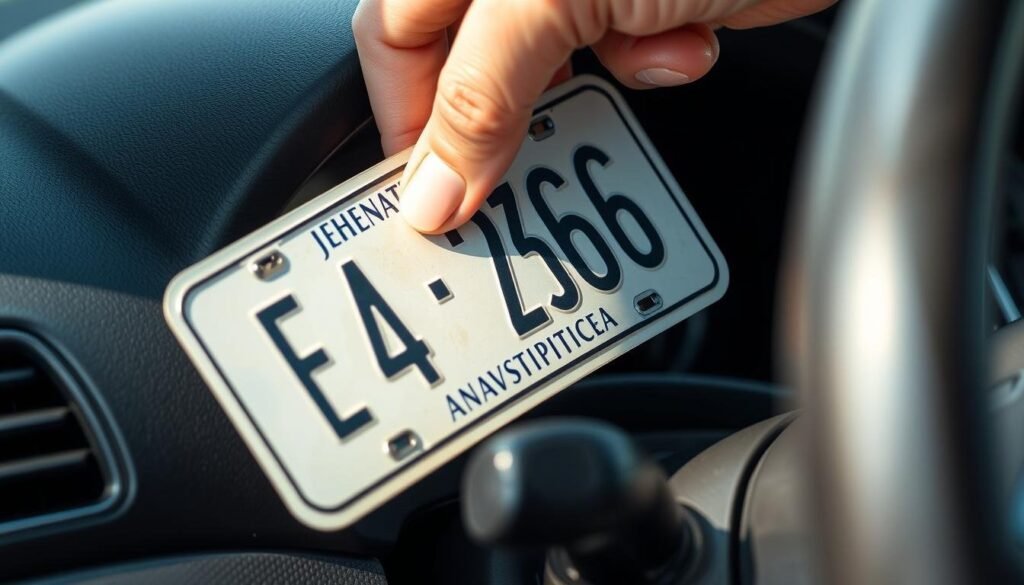Transfer License Plates to Family Members: When a family member hands over their vehicle, knowing how to transfer the license plate is key. In the US, each state has its own rules. But the basic steps are the same.
To make the family vehicle transfer go smoothly, you must follow certain steps. First, tell the state’s Department of Motor Vehicles (DMV) about the change. Then, fill out the needed paperwork.
US laws say you must update the vehicle’s registration to show the new owner. This guide will help you through this process easily.
Contents
- 1 Understanding License Plate Transfers in the United States
- 2 Eligibility Requirements for Family License Plate Transfers
- 3 Preparing for the License Plate Transfer Process
- 4 How to Legally Transfer License Plates Between Family Members
- 5 Completing the Transfer Form
- 6 State-Specific License Plate Transfer Regulations
- 7 Post-Transfer Considerations and Requirements
- 8 Conclusion: Transfer License Plates to Family Members
- 9 FAQ
- 9.1 What are the eligibility requirements for transferring license plates to family members?
- 9.2 What documents are needed to transfer license plates?
- 9.3 How do I complete the transfer form for license plates?
- 9.4 Can I transfer license plates to extended family members, such as siblings or grandparents?
- 9.5 Do I need to notify my insurance provider after transferring license plates?
- 9.6 Are there any state-specific regulations I should be aware of when transferring license plates?
Understanding License Plate Transfers in the United States
Transferring a license plate in the US involves federal and state rules. Federal laws set a basic framework. But, each state has its own rules for license plate transfers.
So, the rules for transferring a license plate differ by state. Knowing your state’s rules is key to understanding the process.
| State | License Plate Transfer Policy | Required Documents |
|---|---|---|
| California | Allowed between family members | Registration, Title, Proof of Insurance |
| Texas | Allowed with certain restrictions | Registration, Title, Proof of Residency |
| New York | Not allowed; new plates issued | Registration, Title, Proof of Insurance |
The table shows how different states have different rules for license plate transfers. Always check with your state’s DMV for the exact requirements.
Eligibility Requirements for Family License Plate Transfers
To legally transfer a license plate to a family member, you must first check if you meet the eligibility requirements. These requirements vary by state. They are set to ensure the transfer is between closely related individuals.
Immediate Family vs. Extended Family
The difference between immediate and extended family is key in determining eligibility. Immediate family includes spouses, parents, children, and siblings. Extended family includes grandparents, grandchildren, aunts, uncles, nieces, and nephews.
The following table summarizes the typical eligibility criteria for family license plate transfers:
| Family Relationship | Eligibility Status |
|---|---|
| Spouse | Eligible |
| Parents/Children | Eligible |
| Siblings | Eligible |
| Extended Family | Varies by State |
It’s crucial to check with your state’s Department of Motor Vehicles (DMV) for specific requirements. They can vary a lot. Knowing these requirements helps make the family member vehicle transfer process easier.
By checking the eligibility criteria, you ensure you follow state rules. This makes the eligibility for license plate transfer process successful.
Preparing for the License Plate Transfer Process
Before starting the license plate transfer, it’s important to know what you need. You must prepare the right documents and information ahead of time. This makes the process easier.
You’ll need to collect several important documents. These include proof of ownership, identification, and any other needed papers. The exact documents you need might change based on your state’s rules. So, it’s a good idea to check with your local DMV.
Here is a summary of the typical documents required for a license plate transfer:
| Document | Description | Required Information |
|---|---|---|
| Proof of Ownership | Vehicle title or registration | Vehicle make, model, and VIN |
| Identification | Driver’s license or state ID | Name, address, and ID number |
| Transfer Application | Completed transfer form | Transferor and transferee information |
Along with the documents, make sure you have the vehicle’s details. This includes the make, model, and VIN. It’s also wise to look at your state’s rules for license plate transfers.
By getting your documents and information ready early, you can make the license plate transfer smooth and quick.
How to Legally Transfer License Plates Between Family Members
Transferring a license plate to a family member is a common need. It’s important to know the legal steps and details involved. This ensures a smooth transfer process.
First, check if your state allows license plate transfers between family members. Most states do, but rules can differ. You can find this info on your state’s Department of Motor Vehicles (DMV) website.
Completing the Transfer Form
After confirming your state’s rules, fill out a transfer form. This form asks for vehicle details, current registration, and the recipient’s information. Make sure to fill it out correctly to avoid delays.
Here’s what you might need:
- The vehicle’s identification number (VIN)
- The current registration details
- The name and address of the family member receiving the transfer
- Proof of relationship (such as a birth certificate or marriage certificate)
| Required Documents | Purpose |
|---|---|
| Vehicle Registration | To prove current registration and ownership |
| Transfer Form | To officially request the transfer |
| Proof of Relationship | To verify the familial relationship |
Once you’ve filled out the form and gathered your documents, submit them to your state’s DMV. You can do this in person, by mail, or online, depending on your state’s rules.
Also, check if there are any fees for the transfer. Some states might charge a small fee for processing.
By following these steps and having the right documents, you can transfer your license plate to a family member. Always check with your state’s DMV for specific requirements to follow their rules.
State-Specific License Plate Transfer Regulations
Knowing the rules for transferring license plates is key for a hassle-free process. When moving plates between family members, it’s important to remember that US license plate regulations vary by state.
States have their own rules for transferring plates. Some let you transfer plates to family members for free, while others charge a fee or need extra paperwork. Always check your state’s rules to follow them.
In California, you can move plates to a new car or a family member, but you must do it quickly and follow certain steps. Texas has its own rules, like making sure the person getting the plates meets certain criteria.
To deal with these state-specific license plate rules well, visit your state’s DMV website or go to a local DMV office. They can tell you the latest on transferring plates, including any forms, fees, and documents you need.
By knowing and following your state’s rules, you can make the license plate transfer easy and worry-free. The main thing is to be aware of the local laws and regulations about transferring plates.
Post-Transfer Considerations and Requirements
After transferring the license plate to a family member, you need to take care of a few things. First, update the vehicle’s registration with the new owner’s details. You’ll need to send the required documents to your state’s Department of Motor Vehicles (DMV).
Next, let your insurance company know about the change. This makes sure the new owner is covered and you’re not responsible for the vehicle anymore.

You might also need to get new registration materials, like a card and sticker, in the new owner’s name. It’s wise to check and update any loan or lease agreements too.
By following these steps, you can make the ownership change go smoothly. This way, you avoid any problems.
Conclusion: Transfer License Plates to Family Members
Now that you’ve gone through the steps to transfer license plates to family members, it’s time to review the important points. A smooth transfer needs careful planning, following state rules, and completing all paperwork on time.
Make sure you’ve met all the requirements and handed in the needed documents. A quick review of the transfer process will confirm you’ve done everything right.
Before you’re done, check that the plates are registered correctly and everyone knows about the change. This step avoids any problems or fines.
By following this guide, you’ve legally moved license plates to your family. For more details on state rules, check the Department of Motor Vehicles website in your state.
See Also: Does Dubai Have Normal License Plates?
FAQ
What are the eligibility requirements for transferring license plates to family members?
Each state has its own rules. But, you can usually transfer plates to family like spouses, parents, or kids.
What documents are needed to transfer license plates?
You’ll need proof of ownership and ID. Also, bring the vehicle’s registration and insurance info.
How do I complete the transfer form for license plates?
Get the form from your state’s DMV website or office. Fill it out right, with all the needed info. Then, submit it with your documents.
Can I transfer license plates to extended family members, such as siblings or grandparents?
It depends on your state’s rules. Some allow it, while others have stricter rules.
Do I need to notify my insurance provider after transferring license plates?
Yes, tell your insurance company. The vehicle’s details will change.
Are there any state-specific regulations I should be aware of when transferring license plates?
Yes, laws vary by state. Check with your local DMV to know what’s needed in your state.

I’m Karsyn Marsh, a blogger from a small village in Texas. I enjoy writing about many topics, and right now, I’m focused on license plates. I share helpful information and facts on LicensePlateFacts.com.



